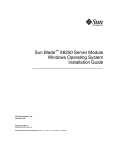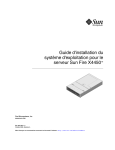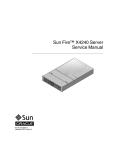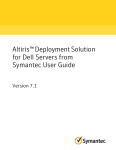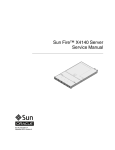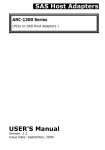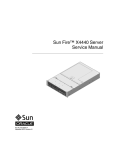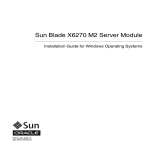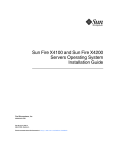Download Sun Fire X4170, X4270, and X4275 Servers Windows Operating
Transcript
Sun Fire™ X4170, X4270, and X4275 Servers Windows Operating System Installation Guide Sun Microsystems, Inc. www.sun.com Part No. 820-5829-11 September 2009, Revision A Submit comments about this document by clicking the Feedback[+] link at: http://docs.sun.com Copyright © 2009 Sun Microsystems, Inc., 4150 Network Circle, Santa Clara, California 95054, U.S.A. All rights reserved. Sun Microsystems, Inc. has intellectual property rights relating to technology embodied in the product that is described in this document. In particular, and without limitation, these intellectual property rights may include one or more of the U.S. patents listed at http://www.sun.com/patents and one or more additional patents or pending patent applications in the U.S. and in other countries. This distribution may include materials developed by third parties. Parts of the product may be derived from Berkeley BSD systems, licensed from the University of California. UNIX is a registered trademark in the U.S. and in other countries, exclusively licensed through X/Open Company, Ltd. Sun, Sun Microsystems, the Sun logo, Java, Sun Studio, Solaris and Sun Fire are trademarks or registered trademarks of Sun Microsystems, Inc., or its subsidiaries, in the U.S. and other countries. Intel is a trademark or registered trademark of Intel Corporation or its subsidiaries in the United States and other countries. The Adobe logo is a registered trademark of Adobe Systems, Incorporated. The OPEN LOOK and Sun™ Graphical User Interface was developed by Sun Microsystems, Inc. for its users and licensees. Sun acknowledges the pioneering efforts of Xerox in researching and developing the concept of visual or graphical user interfaces for the computer industry. Sun holds a non-exclusive license from Xerox to the Xerox Graphical User Interface, which license also covers Sun’s licensees who implement OPEN LOOK GUIs and otherwise comply with Sun’s written license agreements. Use of any spare or replacement CPUs is limited to repair or one-for-one replacement of CPUs in products exported in compliance with U.S. export laws. Use of CPUs as product upgrades unless authorized by the U.S. Government is strictly prohibited. DOCUMENTATION IS PROVIDED "AS IS" AND ALL EXPRESS OR IMPLIED CONDITIONS, REPRESENTATIONS AND WARRANTIES, INCLUDING ANY IMPLIED WARRANTY OF MERCHANTABILITY, FITNESS FOR A PARTICULAR PURPOSE OR NON-INFRINGEMENT, ARE DISCLAIMED, EXCEPT TO THE EXTENT THAT SUCH DISCLAIMERS ARE HELD TO BE LEGALLY INVALID. Copyright © 2009 Sun Microsystems, Inc., 4150 Network Circle, Santa Clara, California 95054, Etats-Unis. Tous droits réservés. Sun Microsystems, Inc. détient les droits de propriété intellectuels relatifs à la technologie incorporée dans le produit qui est décrit dans ce document. En particulier, et ce sans limitation, ces droits de propriété intellectuelle peuvent inclure un ou plus des brevets américains listés à l’adresse http://www.sun.com/patents et un ou les brevets supplémentaires ou les applications de brevet en attente aux Etats - Unis et dans les autres pays. Cette distribution peut comprendre des composants développés par des tierces parties. Des parties de ce produit pourront être dérivées des systèmes Berkeley BSD licenciés par l’Université de Californie. UNIX est une marque déposée aux Etats-Unis et dans d’autres pays et licenciée exclusivement par X/Open Company, Ltd. Sun, Sun Microsystems, le logo Sun, Java, Sun Studio, Solaris et Sun Fire sont des marques, ou des marques déposée de Sun Microsystems, Inc., ou ses filiales, aux Etats-Unis et autres pays. Intel est une marque ou une marque déposée de Intel Corporation, ou ses filiales, aux Etats-Unis, et dans d’autres pays. Le logo Adobe. est une marque déposée de Adobe Systems, Incorporated. L’interface d’utilisation graphique OPEN LOOK et Sun™ a été développée par Sun Microsystems, Inc. pour ses utilisateurs et licenciés. Sun reconnaît les efforts de pionniers de Xerox pour la recherche et le développement du concept des interfaces d’utilisation visuelle ou graphique pour l’industrie de l’informatique. Sun détient une license non exclusive de Xerox sur l’interface d’utilisation graphique Xerox, cette licence couvrant également les licenciés de Sun qui mettent en place l’interface d’utilisation graphique OPEN LOOK et qui, en outre, se conforment aux licences écrites de Sun. L’utilisation de pieces detachees ou d’unites centrales de remplacement est limitee aux reparations ou a l’echange standard d’unites centrales pour les produits exportes, conformement a la legislation americaine en matiere d’exportation. Sauf autorisation par les autorites des EtatsUnis, l’utilisation d’unites centrales pour proceder a des mises a jour de produits est rigoureusement interdite. LA DOCUMENTATION EST FOURNIE "EN L’ETAT" ET TOUTES AUTRES CONDITIONS, DECLARATIONS ET GARANTIES EXPRESSES OU TACITES SONT FORMELLEMENT EXCLUES, DANS LA MESURE AUTORISEE PAR LA LOI APPLICABLE, Y COMPRIS NOTAMMENT TOUTE GARANTIE IMPLICITE RELATIVE A LA QUALITE MARCHANDE, A L’APTITUDE A UNE UTILISATION PARTICULIERE OU A L’ABSENCE DE CONTREFACON. L’ABSENCE DE CONTREFACON. Please Recycle Contents Preface 1. vii Planning the Operating System Installation Supported Operating Systems 1 2 Preinstalled Solaris 10 or OpenSolaris Image Installation Prerequisites Installation Methods 5 Console Outputs 5 3 Installation Boot Media Installation Targets 7 9 Verifying BIOS Settings for New Installations Before You Begin ▼ 2. 3 10 11 View or Edit BIOS Settings for New Installations Install Windows Server 2003 Operating System 17 Task Map for the Windows Server 2003 Installation Boot-Time Device Drivers 18 19 Prepare Mass-Storage Drivers for Delivery 20 Create Floppy Disk For Device Drivers 21 ▼ 11 Create Floppy Disk For Device Driver Installation 21 iii Prepare Floppy Image For Device Drivers ▼ 24 Prepare Floppy Image For Device Driver Installation Install Windows Server 2003 Using Local or Remote Media ▼ Before You Begin 3. Install Windows Server 2003 via PXE 43 44 Install Windows Server 2008 Using Local or Remote Media 4. 52 57 Download the Server-Specific Drivers Installing Server-Specific Device Drivers 58 59 Install the Server-Specific Device Drivers Installing Supplemental Software ▼ 51 57 Downloading Server-Specific Drivers ▼ 46 52 Install Windows Server 2008 via PXE Post Installation ▼ 45 Install Windows Server 2008 Using Local or Remote Media Install Windows Server 2008 via PXE Network ▼ 35 36 Task Map for the Windows Server 2008 Installation Before You Begin 26 36 Install Windows Server 2008 Operating System ▼ 25 Install Windows Server 2003 Using Local or Remote Media Install Windows Server 2003 via PXE Network Environment ▼ 24 59 65 Install the Supplemental Software 67 Configuring Microsoft’s IPMI System Management Driver for Windows Server 2003 R2 SP2 68 ▼ Configure Microsoft’s IPMI System Management Driver for Windows Server 2003 R2 SP2 68 Enable the Option for Wake On LAN Configure the TPM Option A. iv 70 70 Incorporate Sun Fire Server Drivers Into WIM or RIS Images 71 Sun Fire X4170, X4270, and X4275 Servers Windows Operating System Installation Guide • September 2009 Determine Required Drivers Add Drivers to a WIM Image Before you Begin ▼ Add Drivers to the WIM Image Before you Begin Index 72 73 Add Drivers to a RIS Image ▼ 71 73 75 76 Add Drivers to a RIS image 76 83 Contents v vi Sun Fire X4170, X4270, and X4275 Servers Windows Operating System Installation Guide • September 2009 Preface The Sun Fire X4170, X4270, and X4275 Servers Windows Operating System Installation Guide contains operating system installation for the Windows Server 2003 or Windows Server 2008 operating systems and initial software configuration procedures for bringing the server to a configurable and usable state. This document is written for technicians, system administrators, authorized service providers (ASPs), and users who have experience with installing operating systems. Product Updates For product updates that you can download for the Sun Fire X4170, X4175, and X4275 Servers, visit the following web site: http://www.sun.com/download/index.jsp Find the Hardware Drivers section and click x64 Servers & Workstations. The Sun Fire X4170, X4270, and X4275 Servers sites contain updates for firmware and drivers, as well as CD-ROM .iso images. Related Documentation The related documents listed in the following table are available online at: http://docs.sun.com/app/docs/prod/sf.x4170#hic http://docs.sun.com/app/docs/prod/sf.x4270#hic http://docs.sun.com/app/docs/prod/sf.x4275#hic vii viii Title Content Part Number Format Sun Fire X4170, X4270, and X4275 Servers Product Notes Late-breaking information about the server 820-5831 PDF HTML Sun Fire X4170, X4270, and X4275 Servers Getting Started Guide Basic installation information for setting up the server 820-5833 PDF Print Sun Fire X4170, X4270, and X4275 Servers Installation Guide Detailed installation information for setting up the server 820-5827 PDF HTML Print option Sun Fire X4170, X4270, and X4275 Servers Solaris and Linux Operating Systems Installation Guide Installation instructions for the Linux, VMware, and Solaris operating systems 820-5828 PDF HTML Sun Fire X4170, X4270, and X4275 Servers Windows Operating System Installation Guide Installation instructions for the Windows Server operating system 820-5829 PDF HTML Sun Installation Assistant for Linux and Windows User’s Guide Instructions for using the Sun Installation Assistant to install the Windows and Linux operating systems 820-3357 PDF HTML Sun Fire X4170, X4270, and X4275 Servers Service Manual Information and procedures for maintaining and upgrading the server 820-5830 PDF HTML Sun x64 Servers Diagnostics Guide Information for diagnosing and troubleshooting the server 820-6750 PDF HTML x64 Servers Utilities Reference Manual Information for using applications and utilities common to x64 servers 820-1120 PDF HTML Sun Integrated Lights Out Manager 3.0 Documentation Collection These documents cover ILOM features and tasks that are common to servers and server modules that support ILOM 3.0. 820-5523 820-6410 820-6411 820-6412 820-6413 PDF HTML Sun Integrated Lights Out Manager 2.0 User’s Guide ILOM 2.0 features and tasks that are common to servers and server modules that support ILOM 820-1188 PDF HTML Sun Fire X4170, X4270, and X4275 Servers Windows Operating System Installation Guide • September 2009 Title Content Part Number Format Sun Integrated Lights Out Manager (ILOM) 3.0 Supplement for Sun X4170, X4270, and X4275 Servers ILOM 3.0 information that is specific to the Sun Fire X4170, X4270, and X4275 Servers 820-7959 PDF HTML Sun Integrated Lights Out Manager (ILOM) 2.0 Supplement for Sun Fire X4170, X4270, and X4275 Servers ILOM 2.0 information that is specific to the Sun Fire X4170, X4270, and X4275 Servers 820-7629 PDF HTML Sun Fire X4170, X4270, and X4275 Servers Safety and Compliance Guide Hardware safety and compliance information for the server. 820-5832 PDF Important Safety Information for Sun Hardware Systems Multilingual hardware safety and compliance information for all Sun hardware system 816-7190 Print Translated versions of some of these documents are available at the web site described above in French, Simplified Chinese, and Japanese. English documentation is revised more frequently and might be more up-to-date than the translated documentation. Documentation, Support, and Training Sun Function URL Sun Documentation http://docs.sun.com Support http://www.sun.com/support/ Training http://www.sun.com/training/ Preface ix Using UNIX Commands This document might not contain information about basic UNIX® commands and procedures such as shutting down the system, booting the system, and configuring devices. Refer to the following for this information: ■ Software documentation that you received with your system ■ Solaris™ Operating System documentation, which is at: http://docs.sun.com Third-Party Web Sites Sun is not responsible for the availability of third-party web sites mentioned in this document. Sun does not endorse and is not responsible or liable for any content, advertising, products, or other materials that are available on or through such sites or resources. Sun will not be responsible or liable for any actual or alleged damage or loss caused by or in connection with the use of or reliance on any such content, goods, or services that are available on or through such sites or resources. x Sun Fire X4170, X4270, and X4275 Servers Windows Operating System Installation Guide • September 2009 Typographic Conventions Typeface* Meaning Examples AaBbCc123 The names of commands, files, and directories; on-screen computer output Edit your.login file. Use ls -a to list all files. % You have mail. AaBbCc123 What you type, when contrasted with on-screen computer output % su AaBbCc123 Book titles, new words or terms, words to be emphasized. Replace command-line variables with real names or values. Password: Read Chapter 6 in the User’s Guide. These are called class options. You must be superuser to do this. To delete a file, enter rm filename. * The settings on your browser might differ from these settings. Sun Welcomes Your Comments Sun is interested in improving its documentation and welcomes your comments and suggestions. You can submit your comments by going to: http://www.sun.com/hwdocs/feedback Please include the title and part number of your document with your feedback: Sun Fire X4170, X4270, and X4275 Servers Windows Operating System Installation Guide, part number 820-5829-11. Preface xi xii Sun Fire X4170, X4270, and X4275 Servers Windows Operating System Installation Guide • September 2009 CHAPTER 1 Planning the Operating System Installation This chapter identifies the information you need to properly plan the installation of an operating system onto Sun Fire X4170, X4175, and X4275 servers. This chapter contains the following topics: ■ “Supported Operating Systems” on page 2 ■ “Installation Prerequisites” on page 3 ■ “Installation Methods” on page 5 ■ “Verifying BIOS Settings for New Installations” on page 10 1 Supported Operating Systems The Sun Fire X4170, X4175, and X4275 servers support the installation and use of the following operating systems, or a subsequent release of the operating systems. TABLE 1-1 2 Supported Operating Systems Operating System Supported Version For more information, see Windows • Microsoft Windows Server 2003 Enterprise Edition (R2 with SP2, or SP2) (32-bit and 64-bit) • Microsoft Windows Server 2003 Standard Edition (R2 with SP2, or SP2) (32-bit and 64-bit) • Microsoft Windows Server 2008, Standard Edition (32-bit or 64-bit) • Microsoft Windows Server 2008, Enterprise Edition (32-bit or 64-bit) • Microsoft Windows Server 2008, Datacenter Edition (32-bit or 64-bit) • Microsoft Windows Server 2008 R2, Standard Edition • Microsoft Windows Server 2008 R2, Enterprise Edition • Microsoft Windows Server 2008 R2, Datacenter Edition • “Install Windows Server 2003 Operating System” on page 17 • “Install Windows Server 2008 Operating System” on page 43 Linux • SUSE Linux Enterprise Server (SLES) 10 SP2 • Sun Fire X4170, (64-bit) X4270, and X4275 Servers Linux, • SLES 11 (64-bit) VMware, Solaris, and • Red Hat Enterprise Linux (RHEL) 4.8 (32-bit and OpenSolaris 64-bit) Operating Systems • RHEL 5.3 (64-bit) Installation Guide • Oracle Enterprise Linux (OEL) 4.8 and 5.3 (64bit) VMware • • • • Solaris • Solaris 10 05/09 OpenSolaris • OpenSolaris 2009.06 VMware VMware VMware VMware ESX Server 3.5 Update 4 ESXi Server 3.5 Update 4 ESX Server 4.0 ESXi Server 4.0 Sun Fire X4170, X4270, and X4275 Servers Windows Operating System Installation Guide • September 2009 Preinstalled Solaris 10 or OpenSolaris Image You can order either a Solaris 10 Operating System (OS) image or an OpenSolaris OS image preinstalled on the server. If you order a preinstalled image, it is shipped on the hard disk drive. If you need to install another operating system on this drive, you can choose to partition the drive in one of the following ways: ■ Partition the local drive to remove the Solaris 10 or OpenSolaris OS image or ■ Partition the local drive to support a dual-boot operating system configuration The Linux operating system installation procedures described later in this guide explain the appropriate point in the installation program where you can either partition the drive to remove the preinstalled image or to support a dual-boot operating system configuration. Note – To configure the Solaris 10 or OpenSolaris preinstalled OS image, see the Solaris 10 or OpenSolaris Preinstalled OS chapter in the Sun Fire X4170, X4270, and X4275 Servers Installation Guide (820-5827) for details. Installation Prerequisites The following requirements must be met prior to installing an operating system. TABLE 1-2 OS Installation Prerequisites Requirement Mandatory or Optional For More Information, See: The server is mounted and poweredon in a rack. Mandatory • Sun Fire X4170, X4270, and X4275 Servers Installation Guide The SP network management port on the server is configured with an IP address. Mandatory • Sun Fire X4170, X4270, and X4275 Servers Installation Guide or • Sun Integrated Lights Out Manager 2.0 User’s Guide Select a console option and a media Mandatory option for performing the installation, as well as an installation target. • “Installation Methods” on page 5 Ensure that factory-default settings in Recommended the BIOS utility are set. • “Verifying BIOS Settings for New Installations” on page 10 Chapter 1 Planning the Operating System Installation 3 TABLE 1-2 OS Installation Prerequisites (Continued) Requirement Mandatory or Optional For More Information, See: Set up a RAID set on SAS or SATA disk drives configured with a host bus adapter (HBA) (such as REM or FEM), see the documentation supplied with the HBA. Mandatory* • Sun Fire X4170, X4270, and X4275 Servers Service Manual (820-5830) for instructions for adding or replacing disk drives in the server. • Sun™ Disk Management Overview For x64 Sun *For local disk drive OS install targets. Fire and Sun Blade Series Servers (820-6350) Gather the applicable vendor operating system installation documentation. Recommended • Applicable operating system vendor documentation: •Microsoft Windows 2003 Product Documentation at: http://www.microsoft.com/windowsse rver2003/proddoc/default.mspx •Microsoft Windows 2008 Product Documentation at http://www.microsoft.com/windowsse rver2008/en/us/productdocumentation.aspx Mandatory • Sun Fire X4170, X4175, and X4275 Servers Tools and Drivers CD/DVD or • Download version of the Tools and Drivers CD/DVD for the Sun Fire X4170, X4175, and X4275 servers is available at: http://www.sun.com/servers/x64/x4170 /downloads.jsp Recommended • Sun Fire X4170, X4270, and X4275 Servers Product Notes. Note - Use operating system vendor documentation in conjunction with the operating system instructions in this guide. Ensure that you have the Tools and Drivers CD/DVD that was provided with your server. Note - If device drivers are required for your OS installation, the device drivers are provided on the Tools and Driver DVD. Review the Sun Fire X4170, X4270, and X4275 Servers Product Notes Product Notes for late-breaking news about supported operating system software and patches. 4 Sun Fire X4170, X4270, and X4275 Servers Windows Operating System Installation Guide • September 2009 Installation Methods To determine which installation method is best for your infrastructure, consider the options and requirements summarized in the following sections: ■ “Console Outputs” on page 5 ■ “Installation Boot Media” on page 7 ■ “Installation Targets” on page 9 Console Outputs TABLE 1-3 lists the consoles that you can use to capture the output and input of the operating system installation. TABLE 1-3 Console Options for Performing an OS Installation Console Description Setup Requirement Local Console You can install the OS and administer the server by attaching a local console directly to the server SP. 1. Attach a local console to the server. For details, see “Connecting to the ILOM Service Processor for the First Time” in the Sun Fire X4170, X4270, and X4275 Servers Installation Guide. 2. At the ILOM prompt, type your ILOM user name and password. 3. For serial console connections only, establish a connection to the host serial port by typing start /SP/console. The video output is automatically routed to local console. For further details about establishing a connection to the server SP, see the Sun Integrated Lights Out Manager 2.0 User’s Guide. Examples of local consoles include: • Serial console • VGA console, with USB keyboard and mouse Chapter 1 Planning the Operating System Installation 5 TABLE 1-3 Console Options for Performing an OS Installation (Continued) Console Description Setup Requirement Remote Console You can install the OS and administer the server from a remote console by establishing a network connection to the server SP. Examples of remote consoles include: • Web-based client connection using the Sun ILOM Remote Console application • SSH client connection using a serial console 1. Establish an IP address for the server SP. For details, see the Sun Integrated Lights Out Manager 2.0 User’s Guide. 2. Establish a connection between a remote console and the server SP: • For web-based client connection, perform these steps: 1) In a web browser, type the IP address for the server SP; 2) log in to the ILOM web interface; 3) redirect the video output from the server to the web client by launching the Sun ILOM Remote Console; then 4) enable device redirection (mouse, keyboard, etc.) in the Device menu. • For SSH client connection, perform these steps: 1) From a serial console, establish an SSH connection to the server SP (ssh root@ipaddress); 2) log in to the ILOM command-line interface, then 3) redirect the serial output from the server to the SSH client by typing start /SP/console. For additional information about establishing a remote connection to the ILOM SP or using the Sun ILOM Remote Console, see the Sun Integrated Lights Out Manager 2.0 User’s Guide. 6 Sun Fire X4170, X4270, and X4275 Servers Windows Operating System Installation Guide • September 2009 Installation Boot Media You can start the operating system installation to a server by booting a local or remote installation media source. TABLE 1-4 identifies the supported media sources and the setup requirements for each source. TABLE 1-4 Boot Media Options for Performing the OS Installation Installation Media Description Setup Requirement Local Boot Media Local boot media requires a built-in storage device on the server, or an external storage device attached to the server. Supported OS local boot media sources can include: • CD/DVD-ROM installation media, and, if applicable, floppy device driver media To perform the installation using local boot media, perform these steps: 1. If your server does not contain a built-in storage device, attach the appropriate storage device to the front panel of the server using a USB connector. 2. For more information about how to attach local devices to the server, see “Setting Up the Server” in the Sun Fire X4170, X4270, and X4275 Servers Installation Guide. Note - For the Sun Fire X4275 server, which has neither a CD/DVD-ROM drive nor a USB connector on the front panel, use the Sun ILOM Remote Console to redirect the boot media from a remote storage device. For instructions, see instructions for Remote Boot Media in this table. Chapter 1 Planning the Operating System Installation 7 TABLE 1-4 Boot Media Options for Performing the OS Installation (Continued) Installation Media Description Remote Boot Media Remote media requires you to boot the installation over the network. You can start the network installation from a redirected boot storage device or another networked system that exports the installation over the network using a Pre-Boot eXecution environment (PXE). 8 Setup Requirement To redirect the boot media from a remote storage device, perform these steps: 1. Insert the boot media into the storage device, for example: • For CD/DVD-ROM, insert media into the built-in or external CD/DVD-ROM drive. • For CD/DVD-ROM ISO image, ensure that the ISO image(s) are readily available on a network shared location. Supported OS remote media sources • For device driver floppy ISO image, ensure that the can include: ISO image, if applicable, is readily available on a network shared location or on a thumb drive. • CD/DVD-ROM installation media, and, if applicable, floppy • For device driver floppy media, if applicable, insert device driver media floppy media into the external floppy drive. • CD/DVD-ROM ISO installation 2. Establish a web-based client connection to the server image and, if applicable, floppy ILOM SP and launch the Sun ILOM Remote Console ISO device driver media application. • Automated installation image For more details, see the Setup Requirements for web(requires PXE boot) based client connection in TABLE 1-3. 3. In the Device menu of the Sun ILOM Remote Console application, specify the location of the boot media, for example: • For CD/DVD-ROM boot media, select CD-ROM. • For CD/DVD-ROM ISO image boot media, select CD-ROM Image. • For floppy device driver boot media, if applicable, select Floppy. • For floppy image device driver boot media, if applicable, select Floppy Image. For more information about the Sun ILOM Remote Console, see the Sun Integrated Lights Out Manager 2.0 User’s Guide. Sun Fire X4170, X4270, and X4275 Servers Windows Operating System Installation Guide • September 2009 TABLE 1-4 Boot Media Options for Performing the OS Installation (Continued) Installation Media Description Setup Requirement Remote Boot Media, continued Note - An automated installation image enables you to perform the OS installation on multiple servers. By using an automated image, you can ensure configuration uniformity among many systems. To perform the installation using PXE, perform these steps: 1. Configure the network server to export the installation using a PXE boot. 2. Make the OS installation media available for PXE boot. If you are using an automated OS installation image, Automated installations use a Preyou will need to create and provide the automated OS boot eXecution Environment (PXE) installation image, for example: technology to enable the clients without an operating system to boot • Solaris JumpStart Image • RHEL KickStart Image remotely to the automated install server that performs the installation • SLES AutoYaST Image of the operating system. • Windows RIS or WDS Image For detailed instructions for automating the installation setup process, consult the operating system vendor documentation. 3. To boot the installation media, select the PXE boot interface card as the temporary boot device. For details, see the applicable PXE-based operating system installation procedure described later in this chapter. Installation Targets TABLE 1-5 identifies the supported installation targets that you can use to install an operating system. TABLE 1-5 Installation Targets for OS Installations Install Target Description Setup Requirement Supported OS Local Hard Disk Drive (HDD) or Solid State Drive (SSD) You can choose to install the operating system to any of the hard drives or SSDs installed in the server. • Ensure that the HDD or SSD is properly installed and powered-on in the server. For more information about installing and powering on an HDD or SDD, refer to the installation guide or the service manual provided with your server. • All operating systems listed in TABLE 1-1. Chapter 1 Planning the Operating System Installation 9 TABLE 1-5 Installation Targets for OS Installations (Continued) Install Target Description Setup Requirement Supported OS Fibre Channel (FC) Storage Area Network (SAN) device For chassis systems equipped • Ensure FC PCI HBA is properly • All operating with Fibre Channel PCI Host installed in the chassis and is systems listed Bus Adapter (HBA), you can operating. in TABLE 1-1. choose to install the operating For more information about installing system to an external FC storage an HBA in a chassis, refer to the Sun device. Fire X4170, X4270, and X4275 Servers Installation Guide. • The SAN must be installed and configured to make the storage visible to the host. For instructions, refer to the documentation supplied with the FC HBA. Verifying BIOS Settings for New Installations For all new operating system installations on a hard disk drive, you should verify that the following BIOS settings are properly configured before you perform the operating system installation: ■ System time ■ System date ■ Boot order In the BIOS Setup utility, you can set optimal defaults, as well as view and edit BIOS settings as needed. Note that all changes you make in the BIOS Setup utility (through F2) are permanent until the next time you change them. Note – If necessary, you can specify a temporary boot device by pressing F8 during the BIOS start-up. Note that a temporary boot device setting is only in effect for the current system boot. After the system boots from a temporary boot device, the permanent boot device setting specified through F2 (in the BIOS) will be in effect. 10 Sun Fire X4170, X4270, and X4275 Servers Windows Operating System Installation Guide • September 2009 Before You Begin Ensure that the following requirements are met prior to accessing the BIOS Setup utility: ■ Server is mounted and powered on in a rack. For details, see the Sun Fire X4170, X4270, and X4275 Servers Installation Guide. ■ Server is equipped with a hard disk drive (HDD) or a solid state drive (SSD). ■ HDD or SSD is properly installed in the server. For details, see the Sun Fire X4170, X4270, and X4275 Servers Installation Guide. ■ Console connection is established to the server. For details, see “Console Outputs” on page 5. ▼ View or Edit BIOS Settings for New Installations 1. Reset the power on the server. For example: ■ From the ILOM web interface, select the Remote Control --> Remote Power Control tab, then select the Power Cycle option from the Host action drop-down list box. ■ From the local server, press the Power button (approximately 1 second) on the front panel of the server to power off the server, then press the Power button again to power on the server. For further details for powering on or off your server, see the Sun Fire X4170, X4275, and X4275 Servers Service Manual. ■ From the ILOM CLI, type: reset /SYS The BIOS screen appears. Chapter 1 Planning the Operating System Installation 11 2. When prompted in the BIOS screen, press F2 to access the BIOS Setup utility. After a few moments, the BIOS Setup utility appears. 3. To ensure that the factory defaults are set, do the following: 12 Sun Fire X4170, X4270, and X4275 Servers Windows Operating System Installation Guide • September 2009 a. Press F9 to automatically load the optimal factory default settings. A message appears prompting you to continue this operation by selecting OK or to cancel this operation by selecting CANCEL. b. In the message, highlight OK, then press Enter. The BIOS Setup utility screen appears with the cursor highlighting the first value in the system time field. 4. In the BIOS Setup utility, do the following to edit the values associated with the system time or date. a. Highlight the values you want to change. Use the arrow keys to change between the system time and date selection. b. To change the values in the highlighted fields use these keys: ■ PLUS (+) to increment the current value shown ■ MINUS (-) to decrement the current value shown ■ ENTER to move the cursor to the next value field 5. To access the boot settings, select Boot from the BIOS Setup utility menu bar. The Boot Settings dialog appears. Chapter 1 Planning the Operating System Installation 13 6. In the Boot Settings dialog, use the down arrow key to select Boot Device Priority, then press Enter. The Boot Device Priority dialog appears listing the order of the known bootable devices. Note that the boot device order listed on your screen might differ from the device order shown in the sample dialog below. The first device in the list has the highest boot priority. 7. In the Boot Device Priority dialog, do the following to edit the first boot device entry in the list: a. Use the up and down arrow keys to select the first entry in the list, then press Enter. b. In the Options tab, use the up and down arrow keys to select the default permanent boot device, then press Enter. Note that the boot options listed on your screen might differ from the options shown in the sample screen below. 14 Sun Fire X4170, X4270, and X4275 Servers Windows Operating System Installation Guide • September 2009 The device strings listed on the Boot dialog and Options tab are in the format of: device type, slot indicator, and product ID string. Note – You can change the boot order for other devices in the list by repeating Steps 7a and 7b for each device entry you want to change. 8. To save your changes and exit the BIOS Setup utility, press F10. Note – When using the Sun ILOM Remote Console, F10 is trapped by the local OS. You must use the F10 option listed in the Keyboard drop-down menu that is available at the top of the Remote console. Alternatively, you can save the changes and exit the BIOS Setup utility by selecting Save on the Exit menu. A message appears prompting you to save changes and exit setup. 9. In the message dialog, select OK, then press Enter. Chapter 1 Planning the Operating System Installation 15 16 Sun Fire X4170, X4270, and X4275 Servers Windows Operating System Installation Guide • September 2009 CHAPTER 2 Install Windows Server 2003 Operating System This chapter provides information about installing the Windows Server 2003 Operating System (OS). Note – If you are planning to create a RAID set on your disk, the recommended procedure is to create a hardware RAID before you install the OS. For more information, see the Sun™ Disk Management Overview, For x64 Sun Fire and Sun Blade Series Servers (820-6350) This chapter includes the following topics: ■ “Task Map for the Windows Server 2003 Installation” on page 18 ■ “Boot-Time Device Drivers” on page 19 ■ “Prepare Mass-Storage Drivers for Delivery” on page 20 ■ “Install Windows Server 2003 Using Local or Remote Media” on page 25 ■ “Install Windows Server 2003 via PXE Network Environment” on page 35 17 Task Map for the Windows Server 2003 Installation Use TABLE 2-1 To preview the installation process defined as a series of tasks. The table identifies the tasks required and provides pointers to the instructions for performing that task. TABLE 2-1 Task Map for the Windows Server 2003 Installation Step Task Description 1 Review installation prerequisites Verify that all applicable requirements are • TABLE 1-2 “OS Installation met for installing an operating system to Prerequisites” on page 3 a server. 2 Choose an installation method Evaluate and select an installation method that meets the needs of your infrastructure. • “Installation Methods” on page 5 3 Ensure that the BIOS factory defaults are set Verify that the factory default settings in the BIOS are set prior to performing the operating system installation. • “Verifying BIOS Settings for New Installations” on page 10 4 Gather the Windows installation media The Windows OS is shipped with the CD and DVD media and documentation that you will need to install the Windows OS. • You can download or order the media for Windows 2003 at http://www.microsoft.co m 5 Download serverspecific drivers or obtain drivers from Tools and Driver CD Depending on your system, some device • “Download the Server-Specific drivers are required to be installed at boot Drivers” on page 58 time. You can obtain these drivers from the Sun download site or from the Tools and Drivers CD/DVD. 6 Prepare mass-storage drivers Produce the mass-storage drivers floppy required for the Windows 2003 installation. 18 Relevant Topic(s) • “Prepare Mass-Storage Drivers for Delivery” on page 20 Sun Fire X4170, X4270, and X4275 Servers Windows Operating System Installation Guide • September 2009 TABLE 2-1 Task Map for the Windows Server 2003 Installation (Continued) Step Task Description Relevant Topic(s) 7 Perform the Windows OS installation Follow the instructions in this chapter to install the Windows 2003 operating system. • “Install Windows Server 2003 Using Local or Remote Media” on page 25 • “Install Windows Server 2003 via PXE Network Environment” on page 35 8 Install driver(s) and post supplemental software, post installation, if necessary. If the Windows operating system does • “Post Installation” on page 57 not include the necessary device drivers to support your system, you may need to install additional device drivers. If your system includes RAID controllers, you may need to install supplemental software to support these controllers. 9 Enable Wake On LAN feature, if appropriate If required, you can enable the Wake On LAN feature for this server. • “Post Installation” on page 57 Note – The complete Microsoft Windows operating system installation process is not documented in this section. This section describes the steps for booting the Windows Server 2003 media, installing drivers (if necessary) at boot, and partitioning the drive. For additional information, consult the Microsoft Windows 2003 product documentation at http://www.microsoft.com/windowsserver2003/proddoc/default.mspx Boot-Time Device Drivers TABLE 2-2 identifies the device drivers that you may need to install at boot time while performing the Windows Server 2003 installation. Chapter 2 Install Windows Server 2003 Operating System 19 TABLE 2-2 Windows 2003 Server-specific Drivers Installed at Boot Time Device Driver Description Intel SATA Driver The Intel SATA device driver must be available at boot time if installing to a local SATA hard disk drive (HDD). LSI SAS/SATA RAID Driver The LSI SAS/SATA device driver must be available at boot time if installing to a local SAS or SATA hard disk drive (HDD). Sun StorageTek SAS/SATA RAID Driver The Sun StorageTek SAS/SATA device driver must be available at boot time if installing to a local SAS or SATA hard disk drive (HDD). QLogic SAN Driver The QLogic Fibre Channel (FC) device driver must be installed at installation boot time if your installation target is a QLogic FC Storage Area Network (SAN) device. Emulex SAN Driver The Emulex FC device driver must be installed at installation boot time if your installation target is a Emulex FC SAN device. The boot-time device drivers listed in TABLE 2-2 are included on the Tools and Drivers CD/DVD that ships with the server. However, if you do not have the Tools and Drivers CD/DVD, you can download these same drivers from the Sun download site. For instructions on downloading the server-specific drivers package, which includes the boot-time device drivers, see “Downloading Server-Specific Drivers” on page 57. Prepare Mass-Storage Drivers for Delivery This section contains instructions on preparing the necessary mass-storage drivers media for a local or remote Windows Server 2003 installation. You can choose to prepare the mass-storage drivers on a floppy disk or floppy image, see TABLE 2-3. TABLE 2-3 20 Mass-Storage Driver Media Options Media Option Section to Read Floppy Disk Local or Remote “Create Floppy Disk For Device Drivers” on page 21 Floppy Image “Prepare Floppy Image For Device Drivers” on page 24 Sun Fire X4170, X4270, and X4275 Servers Windows Operating System Installation Guide • September 2009 Create Floppy Disk For Device Drivers Perform the following procedure in this section if you have chosen to create a floppy disk to store the required Windows 2003 device drivers. Before You Begin Prior to performing the following procedure to create a floppy disk, ensure that the following requirements have been met: ■ The system being used to create the floppy disk is connected to a USB floppy drive ■ Floppy disk media is available ■ FloppyPack_x_x_x.zip file is available You can obtain the FloppyPack_x_x_x.zip file on the Tools and Drivers CD/DVD or you can download it from the Sun download site. For instructions about how to download it from Sun, see “Downloading Server-Specific Drivers” on page 57. Note – The _x_x_x number identifies the version of the package (for example, FloppyPack_1_1_4.zip). ▼ Create Floppy Disk For Device Driver Installation Sun provides a Sun Mass-Storage Driver Disk Creation wizard to help you create a floppy disk. Follow these steps to create a floppy disk using the Sun Mass-Storage Driver Disk Creation wizard. 1. Start the Sun Mass-Storage Driver Disk Creation wizard from one of the following media sources: ■ Tools and Driver CD Perform the following steps to start the wizard: a. Insert the Tools and Drivers CD/DVD into a Windows system with a CD/DVD drive. The CD will start automatically. b. At the main menu, select Make a Windows Server 2003 Mass-Storage Driver Disk, and then proceed to Step 2. The Welcome page for the Mass-Storage Driver Disk Creation wizard appears. Or ■ FloppyPack_x_x_x.zip file (obtained from Sun download site) Chapter 2 Install Windows Server 2003 Operating System 21 Perform the following steps to copy and extract the files and start the wizard. a. On a system running Microsoft Windows software with a floppy drive, copy the FloppyPack_x_x_x.zip file to a temporary directory. b. Start Windows Explorer. c. Navigate to the folder where you placed the downloaded file. d. Select FloppyPack_x_x_x.zip. e. On the File menu, click Extract All to extract the files into a new (empty) folder. Note – If your version of Windows Explorer does not natively support compressed folders, use a third-party utility to extract the contents of the zip file. Make sure to maintain the directory structure of the folders after extracting them. f. Start Windows Explorer and navigate to the folder containing the extracted files. g. In Windows Explorer, open the directory containing the extracted files and double-click the mkfloppy.exe wizard, and then proceed to Step 2. The Welcome page for the Mass-Storage Driver Disk Creation wizard appears. 2. In the Mass-Storage Driver Disk Creation wizard Welcome page, do the following: a. Click Next and follow the instructions in the wizard to create the massstorage driver floppy disk for your server. b. Insert a blank floppy disk into drive A: when prompted. The Format 3 1/2 Floppy dialog appears. 22 Sun Fire X4170, X4270, and X4275 Servers Windows Operating System Installation Guide • September 2009 3. In the Format 3 1/2 Floppy dialog, click the Start button to begin formatting. Chapter 2 Install Windows Server 2003 Operating System 23 4. When the floppy disk formatting completes, click the Close button. The Format 3 1/2 Floppy page closes and you are returned to the Mass-Storage Driver Disk Creation wizard. 5. Click Next and follow the instructions in the wizard to complete the creation of the mass-storage driver floppy disk. 6. Proceed to “Install Windows Server 2003 Using Local or Remote Media” on page 25. Prepare Floppy Image For Device Drivers Perform the following procedure in this section if you have chosen to use the floppy image media to install the required Windows 2003 device drivers. Before You Begin Prior to performing the following procedure to prepare the floppy image for device driver installation, ensure that the following requirements have been met: ■ Obtain FloppyPack_x_x_x.zip driver package from the Tools and Drivers CD/DVD or from the Sun download site as described in “Downloading ServerSpecific Drivers” on page 57 ■ The system hosting the Sun ILOM Remote Console must have local or network access to the FloppyPack_x_x_x.zip driver package. ▼ Prepare Floppy Image For Device Driver Installation 1. Obtain the floppy image file containing the device drivers from one of the following media sources: ■ Tools and Drivers CD/DVD Perform these steps to access the floppy package: a. Insert the CD into the Sun ILOM Remote Console system. b. Navigate to the following directory: windows\w2k3\packages\FloppyPack\image c. Proceed to Step 2. ■ FloppyPack.zip file (from the Sun download site) a. Copy the FloppyPack_x_x_x.zip file to a temporary directory. b. Start Windows Explorer. 24 Sun Fire X4170, X4270, and X4275 Servers Windows Operating System Installation Guide • September 2009 c. Navigate to the temporary folder where you placed the downloaded file. d. Select FloppyPack_x_x_x.zip. e. On the File menu, click Extract All to a new empty folder. Note – If your version of Windows Explorer does not natively support compressed folders, use a third-party utility to extract the contents of the zip file. Make sure to maintain the directory structure of the folders after extracting them. f. Navigate to the image folder where the extracted files reside then proceed to Step 2. 2. Copy the appropriate floppy image file to a local or network shared location where the Sun ILOM Remote Console system can access it during the Windows installation (for example, intelsmilsi.img). For instructions for enabling image file media redirection in the Sun ILOM Remote Console, see the Sun Integrated Lights Out Manager 2.0 User’s Guide. 3. Proceed to “Install Windows Server 2003 Using Local or Remote Media” on page 25. Install Windows Server 2003 Using Local or Remote Media The following procedure describes how to boot the Windows Server 2003 operating system from local or remote media. It assumes you are booting the Windows installation media from one of the following sources: ■ Windows CD or DVD (internal or external CD/DVD) ■ Windows 2003 ISO image (network repository) Note – If you are booting the installation media from a PXE environment, refer to “Install Windows Server 2003 via PXE Network Environment” on page 35 for instructions. Before You Begin Prior to performing the installation, the following requirements must be met: Chapter 2 Install Windows Server 2003 Operating System 25 ■ All applicable installation prerequisites for installing an operating system should have been met. For further information about these prerequisites, see TABLE 1-2 “OS Installation Prerequisites” on page 3. ■ An installation method (for example: console, boot media, and installation target) should have been chosen and established prior to performing the installation. For more information about these setup requirements, see “Installation Methods” on page 5. After completing this procedure, you will need to perform the post installation tasks as described in “Post Installation” on page 57. ▼ Install Windows Server 2003 Using Local or Remote Media 1. Ensure that the installation media is available to boot. Note – For the Sun Fire X4275 server, which has neither a CD/DVD-ROM drive nor a USB connector on the front panel, use the Sun ILOM Remote Console to redirect the boot media from a remote storage device. For instructions, see instructions for Remote Boot Media in TABLE 1-4 “Boot Media Options for Performing the OS Installation” on page 7. For example: ■ For distribution CD/DVD—Insert the Windows 2003 Distribution media (CD labeled #1 or the single DVD) into the local or remote USB CD/DVD-ROM drive. ■ For ISO image—Ensure that the ISO images are available and that the ILOM Remote Console application is aware of the first ISO image location. For additional information about how to set up the installation media, see TABLE 1-4 “Boot Media Options for Performing the OS Installation” on page 7. 2. Reset the power on the server. For example: ■ From the ILOM web interface, select the Remote Control --> Remote Power Control tab, then select the Power Cycle option from the Host action drop-down list box. ■ From the local server, press the Power button (approximately 1 second) on the front panel of the server to power off the server, then press the Power button again to power on the server. For further details for powering on or off your server, see the Sun Fire X4170, X4275, and X4275 Servers Service Manual. 26 Sun Fire X4170, X4270, and X4275 Servers Windows Operating System Installation Guide • September 2009 ■ From the ILOM CLI, type: reset /SYS The BIOS screen appears. 3. When the Press F8 for BBS POPUP prompt appears on the BIOS POST screen, press F8. The BBS POPUP menu allows you to select a boot device. 4. Once the BIOS POST process is complete, the Boot Device menu appears. Note – The screen that appears in your installation may be different depending on the type of disk controller installed in your server. Chapter 2 Install Windows Server 2003 Operating System 27 5. In the Boot Device menu, select a boot device based on the Windows media installation method you elected to use and press Enter. For example: ■ If you elected to use the Windows local delivery method, select CD/DVDW. ■ If you elected to use the ILOM Remote Console method, select Virtual CDROM. 6. When prompted with Press any key to boot from CD, quickly press any key. The Windows Setup process begins. 7. When you see the following prompt at the bottom of the Windows Setup dialog, quickly press F6: Press F6 if you need to install a third party SCSI or RAID driver. 28 Sun Fire X4170, X4270, and X4275 Servers Windows Operating System Installation Guide • September 2009 Note – The above prompt lasts for approximately five seconds and is easy to miss. If you do not press F6 while the prompt is displayed, the dialog allowing you to specify additional drivers is not displayed and the installation will fail. If this happens, restart the server on which you are performing the installation and go back to Step 3. After pressing F6, the setup process continues and the following dialog appears. This dialog gives you the option of specifying additional mass-storage devices. 8. Make sure that the mass-storage drivers are accessible according to the massstorage driver installation method that you have selected. For example: ■ For Floppy Disk Local—Mass-storage drivers floppy disk in floppy drive A on the server. ■ For Floppy Disk Remote—Mass-storage drivers floppy disk in the Sun ILOM Remote Console system floppy drive. ■ For Floppy Image—Use the floppy image file accessible from the Sun ILOM Remote Console system (for example, intelsmilsi.img). 9. Press S to specify additional devices. A dialog appears listing the available drivers. Chapter 2 Install Windows Server 2003 Operating System 29 Note – The above dialog will vary depending on the type of mass-storage controller driver(s) you are installing. 10. In the Select Adapter dialog, select the appropriate mass-storage controller driver version (Windows 32-bit or 64-bit) that you are installing, then press Enter. For example: ■ For servers with an LSI-based integrated RAID controller, select: LSI Logic Fusion-MPT SAS Driver (32-bit or 64-bit) ■ For servers with an Adaptec-based integrated RAID controller, select: Adaptec SAS/SATA-II RAID Driver (32-bit or 64-bit) ■ For servers with an Intel-based integrated disk controller, select: Intel(R) ICH10R SATA AHCI Controller (32-bit or 64-bit) A dialog similar to the following appears stating that the setup will load support for the specified mass-storage device. 30 Sun Fire X4170, X4270, and X4275 Servers Windows Operating System Installation Guide • September 2009 11. Press Enter to continue. The Windows setup process continues and a Setup Notification dialog appears. 12. At the Setup Notification dialog, press Enter to continue. The Welcome to Setup dialog appears. Chapter 2 Install Windows Server 2003 Operating System 31 13. At the Welcome to Setup dialog, press Enter to continue. The Windows Licensing Agreement dialog appears. 14. To accept the license agreement, press F8. A dialog appears that shows the existing partitions on the server and the unpartitioned space. Note – Any previous installations on the server’s boot disk will cause the partitioning dialog to appear. 32 Sun Fire X4170, X4270, and X4275 Servers Windows Operating System Installation Guide • September 2009 15. To delete the existing partition, press D. A confirmation dialog appears to verify that you really want to delete the partition. 16. Press Enter to continue. Another confirmation dialog with a caution notice appears and describes the partition that you are about to delete. 17. Press L to delete the partition. The partition is deleted and the a dialog appears that shows the unpartitioned space on the server’s disk. 18. To create a partition in the unpartitioned space, press C. A dialog appears that allows you to specify the size of the new partition. 19. Either accept the default size of the partition to be created or use the Back Space key to delete the size specified and enter a new size and press Enter. A recommended size of 40,000 megabytes is usually sufficient for a Windows installation. This will leave adequate space on the disk for installations of other media. A partition confirmation windows appears. 20. Press Enter to accept the partition. A partition formatting dialog appears. Chapter 2 Install Windows Server 2003 Operating System 33 21. Use the up and down arrow keys to select the <Quick> menu option and press Enter to format the partition. The setup process formats the partition and copies the files to the Windows installation folders. This process might take several minutes 22. Follow the on-screen instructions to complete the initial setup of Windows Server 2003 until you are prompted with the following message: Remove disks or other media. Press any key to restart. When this message appears you will need to complete one of the following steps, depending on which driver delivery method you have chosen, to complete the installation: ■ Floppy Disk Local—Remove the floppy disk from the floppy drive on the server. ■ Floppy Disk Remote—Remove the floppy disk from the Sun ILOM Remote Console system. ■ Floppy Image—Deselect Floppy Image from the Sun ILOM Remote Console Devices menu. Then, press any key to restart the system and complete the Windows Server 2003 Installation. 23. Proceed to “Post Installation” on page 57. 34 Sun Fire X4170, X4270, and X4275 Servers Windows Operating System Installation Guide • September 2009 Install Windows Server 2003 via PXE Network Environment This section explains the initial information you will need to install the Windows Server 2003 operating system software over an established PXE-based network via a customer-provided Windows 2003 Remote Installation Services (RIS) image. Note – As an alternative, you can install the Windows 2003 operating system over an established PXE-based network via a customer-provided Windows Deployment Services (WDS) image. After completing this procedure, you will need to perform the post installation tasks as described in “Post Installation” on page 57. Before You Begin The following requirements must be met prior to performing the Windows Server 2003 installation from a RIS image. ■ ■ To use PXE to boot the installation media over the network: ■ Configure the network (NFS, FTP, HTTP) server to export the installation tree. ■ Configure the files on the TFTP server that are necessary for PXE booting. ■ Configure the Sun server MAC network port address to boot from the PXE configuration. ■ Configure DHCP To use a RIS image to perform the installation: ■ Create the RIS installation image. Follow the RIS installation instructions in the Windows Server 2003 documentation. ■ Add the required system device drivers to the RIS installation image. For instruction, see Appendix A “Incorporate Sun Fire Server Drivers Into WIM or RIS Images” on page 71. ■ RIS Administrator password. Chapter 2 Install Windows Server 2003 Operating System 35 ▼ Install Windows Server 2003 via PXE 1. Ensure that the PXE network environment is properly set up and the Windows Server 2003 installation media is available for PXE boot. Note – Information concerning how to properly set up and deploy a RIS network environment is outside the scope of this installation guide. For these details, see Microsoft’s documentation for deploying and using Remote Installation Services. 2. Reset the power on the server. For example: ■ From the ILOM web interface, select the Remote Control --> Remote Power Control tab, then select the Power Cycle option from the Host action drop-down list box. ■ From the local server, press the Power button (approximately 1 second) on the front panel of the server to power off the server, then press the Power button again to power on the server. For further details for powering on or off your server, see the Sun Fire X4170, X4275, and X4275 Servers Service Manual. 36 Sun Fire X4170, X4270, and X4275 Servers Windows Operating System Installation Guide • September 2009 ■ From the ILOM CLI, type: reset /SYS The BIOS screen appears. Note – The next events occur very quickly, so focused attention is needed for the following steps. Watch carefully for these messages as they appear on the screen for a brief time. You might want to enlarge the size of your screen to eliminate scroll bars. 3. Press F8 to specify a temporary boot device. The Please Select Boot Device menu appears. 4. In the Please Select Boot Device menu, select the appropriate PXE installation boot device and press Enter. The PXE installation boot device is the physical network port configured to communicate with your network installation server. Note – The boot device options shown on the following Select Boot Device dialog may be different from the options listed on your screen. Chapter 2 Install Windows Server 2003 Operating System 37 The Boot Agent dialog appears. 5. In the Boot Agent dialog, press F12 for a network service boot. 38 Sun Fire X4170, X4270, and X4275 Servers Windows Operating System Installation Guide • September 2009 The Welcome to Client Installation wizard appears. 6. In the Welcome to Client Installation wizard, press Enter to continue. The next dialog prompts you for a user name, password, and domain name. 7. In the user name and password dialog, specify your user name and password, then press Enter. Use the Tab key to move between fields. Chapter 2 Install Windows Server 2003 Operating System 39 The Windows Server 2003 version dialog appears. 8. In the Windows Server 2003 version dialog, select the version (32-bit or 64-bit) you are installing, then press Enter. The Windows Server 2003 operating system choice dialog appears. 9. In the OS choice dialog, select the OS option you are installing, then press Enter. Note – The OS choice dialog identifies the names of the OS images that are available for you to install from your RIS server. The OS choice dialog from your RIS server will list different options from the ones shown in the example dialog below. 40 Sun Fire X4170, X4270, and X4275 Servers Windows Operating System Installation Guide • September 2009 A Caution dialog appears. 10. In the Caution dialog, press Enter to continue. The Installation Information dialog appears. 11. In the Installation Information dialog, press Enter to continue. The Administrator Password dialog appears. Chapter 2 Install Windows Server 2003 Operating System 41 12. In the Administrator Password dialog, specify an OS Administrator password and press Enter. Note that this password is assigned to the OS installation target. You will be asked to confirm the password. 13. In the Administrator Password Confirmation dialog, retype the password and press Enter. The Windows Setup starts and a message appears that the setup is formatting the partition. 14. Proceed to “Post Installation” on page 57. 42 Sun Fire X4170, X4270, and X4275 Servers Windows Operating System Installation Guide • September 2009 CHAPTER 3 Install Windows Server 2008 Operating System This chapter provides information about installing the Windows Server 2008 and Windows Server 2008 R2 Operating Systems (OS). Note – If you are planning to create a RAID set on your disk, the recommended procedure is to create a hardware RAID before you install the OS. For more information, see the Sun™ Disk Management Overview, For x64 Sun Fire and Sun Blade Series Servers (820-6350) This chapter includes the following topics: ■ “Task Map for the Windows Server 2008 Installation” on page 44 ■ “Install Windows Server 2008 Using Local or Remote Media” on page 45 ■ “Install Windows Server 2008 via PXE Network” on page 51 43 Task Map for the Windows Server 2008 Installation Use TABLE 3-1 to preview the installation process defined as a series of tasks. The table defines the required tasks, describes them, and provides pointers to the instructions for performing that task. TABLE 3-1 Task Map for the Windows Server 2008 Installation Step Task Description 1 Review installation prerequisites Verify that all applicable requirements are • TABLE 1-2 “OS Installation met for installing an operating system to Prerequisites” on page 3 a server. 2 Choose an installation method Evaluate and select an installation method that meets the needs of your infrastructure. • “Installation Methods” on page 5 3 Ensure that the BIOS factory defaults are set Verify that the factory default settings in the BIOS are set prior to performing the operating system installation. • “Verifying BIOS Settings for New Installations” on page 10 4 Gather the Windows installation media The Windows OS is shipped with the CD and DVD media and documentation that you will need to install the Windows OS. • You can download or order the media for Windows 2003 at http://www.microsoft.co m 5 Perform the Windows 2008 OS installation Follow the instructions in this chapter to install the Windows 2008 operating system. • “Install Windows Server 2008 Using Local or Remote Media” on page 45 • “Install Windows Server 2008 via PXE Network” on page 51 6 Install driver(s) and supplemental software post installation, if applicable. If necessary, install the updated serverspecific drivers and the server supplemental software. • “Post Installation” on page 57 9 Enable Wake On LAN feature, if appropriate If required, you can enable the Wake On LAN feature for this server. • “Post Installation” on page 57 44 Relevant Topic(s) Sun Fire X4170, X4270, and X4275 Servers Windows Operating System Installation Guide • September 2009 Note – The complete Microsoft Windows operating system installation process is not documented in this section. This section walks you through the steps for booting the Windows Server 2008 media, installing drivers (if necessary) at boot, and partitioning the drive. For additional information, consult the Microsoft Windows 2008 Product Documentation at http://www.microsoft.com/windowsserver2008/en/us/productdocumentation.aspx Install Windows Server 2008 Using Local or Remote Media The following procedure describes how to boot the Windows Server 2008 operating system from local or remote media. It assumes you are booting the Windows installation media from one of the following sources: ■ Windows 2008 CD or DVD (internal or external CD/DVD) ■ Windows 2008 ISO image (network repository) Note – If you are booting the installation media from a PXE environment, refer to “Install Windows Server 2008 via PXE Network” on page 51 for instructions. Before You Begin Prior to performing the installation, the following requirements must be met: ■ All applicable installation prerequisites for installing an operating system should have been met. For further information about these prerequisites, see TABLE 1-2 “OS Installation Prerequisites” on page 3. ■ An installation method (for example: console, boot media, and install target) should have been chosen and established prior to performing the installation. For more information about these setup requirements, see “Installation Methods” on page 5. After completing this procedure, you will need to perform the post installation tasks as described in “Post Installation” on page 57. Chapter 3 Install Windows Server 2008 Operating System 45 ▼ Install Windows Server 2008 Using Local or Remote Media 1. Ensure that the installation media is available to boot. Note – For the Sun Fire X4275 server, which has neither a CD/DVD-ROM drive nor a USB connector on the front panel, use the Sun ILOM Remote Console to redirect the boot media from a remote storage device. For instructions, see instructions for Remote Boot Media in TABLE 1-4 “Boot Media Options for Performing the OS Installation” on page 7. For example: ■ For distribution CD/DVD, insert the Windows 2008 Distribution media (CD labeled #1 or the single DVD) into the local or remote USB CD/DVD-ROM drive. ■ For ISO image, ensure that the ISO images are available and that the ILOM Remote Console application is aware of the first ISO image location. For additional information about how to set up the installation media, see TABLE 1-4 “Boot Media Options for Performing the OS Installation” on page 7. 2. Reset the power on the server. For example: ■ From the ILOM web interface, select the Remote Control --> Remote Power Control tab, then select the Power Cycle option from the Host action drop-down list box. ■ From the local server, press the Power button (approximately 1 second) on the front panel of the server to power off the server, then press the Power button again to power on the server. For further details for powering on or off your server, see the Sun Fire X4170, X4275, and X4275 Servers Service Manual. ■ From the ILOM CLI, type: reset /SYS The BIOS screen appears. 46 Sun Fire X4170, X4270, and X4275 Servers Windows Operating System Installation Guide • September 2009 3. In the BIOS screen, press F8. The Boot Device dialog appears. Note – The dialog that appears in your installation may be different depending the type of disk controller installed in your server. Chapter 3 Install Windows Server 2008 Operating System 47 4. In the Boot Device dialog, select the menu item according to the Windows media installation method you elected to use and press Enter. For example: ■ If you elected to use the Windows Local delivery method, select CD/DVDW. ■ If you elected to use the Sun ILOM Remote Console delivery method, select Virtual CDROM. 5. When prompted with Press any key to boot from CD, press any key. The Windows installation wizard starts. Continue the Windows installation wizard until the Installation Type dialog appears. 48 Sun Fire X4170, X4270, and X4275 Servers Windows Operating System Installation Guide • September 2009 6. In the Installation Type dialog, click Custom (advanced). The Where Do You Want to Install Windows dialog appears. Chapter 3 Install Windows Server 2008 Operating System 49 7. In the Where Do You Want To Install Windows? dialog, do one of the following: ■ If you do not want to override the Windows Default partition information, click Next then skip to Step 9. ■ If you do want to override the Windows default partition information, click the Driver options (advanced) option and proceed to Step 8. Caution – Formatting or re-partitioning a pre-existing partition will destroy all data on the partition. The Where do you want to Install Windows? dialog appears. 8. In the Where to Install Windows dialog, do the following: a. Click Delete to delete the existing partition. A confirmation window appears. b. Click Ok to confirm the partition deletion. c. Click New to create the new partition. d. Change partition size settings as needed, and then click Apply. The partition is created. 50 Sun Fire X4170, X4270, and X4275 Servers Windows Operating System Installation Guide • September 2009 e. Click Next and proceed to the next step. The Windows installation begins. The server will reboot multiple times during the installation process. This process could take several minutes. 9. When the Windows installation is complete, Windows starts and prompts you to change the user password. 10. In the user password dialog, click OK and set up the initial user login account. Note – Windows Server 2008 enforces stronger password schemes for user accounts. Password standards include restrictions on length, complexity and history. For more details, click the Accessibility link at the account creation page. After the initial user account is created, the Windows Server 2008 desktop appears. 11. Proceed to “Post Installation” on page 57. Install Windows Server 2008 via PXE Network This section explains the initial information you will need to install the Windows Server 2008 operating system over an established PXE-based network using a customer-provided Windows Deployment Services (WDS) image. Topics included in this section: ■ “Before You Begin” on page 52 Chapter 3 Install Windows Server 2008 Operating System 51 ■ “Install Windows Server 2008 via PXE” on page 52 Note that the procedure presented in this section documents the initial steps to install Windows 2008 over the network using a Windows Deployment Services (WDS) image. Specifically, it explains the steps for selecting the server PXE network interface card that will be communicate with your WDS installation server. For further information about using a WDS image to install the Windows Server 2008 operating system, see Microsoft’s Windows Deployment Services documentation. After completing this procedure, you will need to perform the post installation tasks as described in “Post Installation” on page 57. Before You Begin ■ ■ To use PXE to boot the installation media over the network: ■ Configure the network (NFS, FTP, HTTP) server to export the installation tree. ■ Configure the files on the TFTP server that are necessary for PXE booting. ■ Configure the Sun server MAC network port address to boot from the PXE configuration. ■ Configure DHCP To use a WIM image to perform the installation, you must: ■ Create the WIM installation image. Follow the WIM installation instructions in the Windows Server 2008 documentation. ■ Add the required system device drivers to the WIM installation image. For instruction, see Appendix A “Incorporate Sun Fire Server Drivers Into WIM or RIS Images” on page 71. ■ WIM Administrator password. ▼ Install Windows Server 2008 via PXE 1. Reset the power on the server. For example: 52 ■ From the ILOM web interface, select the Remote Control --> Remote Power Control tab, then select the Power Cycle option from the Host action drop-down list box. ■ From the local server, press the Power button (approximately 1 second) on the front panel of the server to power off the server, then press the Power button again to power on the server. Sun Fire X4170, X4270, and X4275 Servers Windows Operating System Installation Guide • September 2009 For further details for powering on or off your server, see the Sun Fire X4170, X4275, and X4275 Servers Service Manual. ■ From the ILOM CLI, type: reset /SYS The BIOS screen appears. Note – The next events occur very quickly; therefore, focused attention is needed for the following steps. Watch carefully for these messages as they appear on the screen for a brief time. You might want to enlarge the size of your screen to eliminate scroll bars. 2. Press F8 to specify a temporary boot device. The Please Select Boot Device menu appears. Chapter 3 Install Windows Server 2008 Operating System 53 3. In the Please Select Boot Device menu, select the appropriate PXE installation boot device and press Enter. The PXE installation boot device is the physical network port configured to communicate with your network installation server. The Boot Agent dialog appears. 54 Sun Fire X4170, X4270, and X4275 Servers Windows Operating System Installation Guide • September 2009 4. In the Boot Agent dialog, press F12 for a network service boot. 5. Continue the normal Windows Server 2008 WDS network installation. For additional information, consult Microsoft’s Windows Deployment Services product documentation. 6. Proceed to “Post Installation” on page 57. Chapter 3 Install Windows Server 2008 Operating System 55 56 Sun Fire X4170, X4270, and X4275 Servers Windows Operating System Installation Guide • September 2009 CHAPTER 4 Post Installation After completing the Windows 2003 or Windows 2008 installation and rebooting the operating system, you should review the following post installation tasks and, if necessary, perform the tasks that are applicable to your system. ■ “Downloading Server-Specific Drivers” on page 57 ■ “Installing Server-Specific Device Drivers” on page 59 ■ “Installing Supplemental Software” on page 65 ■ “Configuring Microsoft’s IPMI System Management Driver for Windows Server 2003 R2 SP2” on page 68 ■ “Enable the Option for Wake On LAN” on page 70 ■ “Configure the TPM Option” on page 70 Downloading Server-Specific Drivers This section describes how to download the server-specific driver packages needed for Windows Server installations. Note – If you have the Tools and Drivers CD/DVD and want to use it, you can skip this section and proceed to “Installing Server-Specific Device Drivers” on page 59. However, the latest version of the Tools and Drivers CD/DVD is available as a downloadable image on the Sun download site, which is specified in “Download the Server-Specific Drivers” on page 58. 57 ▼ Download the Server-Specific Drivers 1. Go to the driver download site for your server. ■ For the X4170 server: http://www.sun.com/servers/x64/x4170/downloads.jsp ■ For the X4270 server: http://www.sun.com/servers/x64/x4270/downloads.jsp ■ For the X4275 server: http://www.sun.com/servers/x64/x4275/downloads.jsp 2. Choose one of the following download options: ■ ■ If you are installing the server-specific drivers using media, download Windows.zip to a hard drive location or media that will be accessible during the installation. Extract the following sub-packages contained in Windows.zip: ■ FloppyPack_x_x_x.zip (contains Intel SATA drivers, LSI SAS/SATA RAID drivers, Sun StorageTek SAS/SATA RAID drivers, QLogic SAN drivers, and Emulex SAN drivers). You will use this file to create driver media for your installation of Windows Server 2003. ■ InstallPack_x_x_x.exe (program to install all server-specific device drivers after installing Windows Server) You will use this file to install all of the server-specific drivers. ■ DriverPack_x_x_x.zip (for experts only, server-specific driver archive for Windows Server, English). Download this file if you want to incorporate Sun server drivers into a Remote Installation Service (RIS) image. ■ OptPack_x_x_x.zip (for experts only, supplemental software archive). Download this file if you want to incorporate the supplemental software into a PXE installation. If you are installing server-specific drivers using a PXE server (advanced installation), extract the contents of the DriverPack_x_x_x.zip file on to the PXE server. Note – The _x_x_x number identifies the version of the package (for example, FloppyPack_1_1_4.zip). 3. Proceed to “Installing Server-Specific Device Drivers” on page 59. 58 Sun Fire X4170, X4270, and X4275 Servers Windows Operating System Installation Guide • September 2009 Installing Server-Specific Device Drivers Sun provides a wizard to install Sun server-specific device drivers and supplemental software. The server-specific device drivers are provided to support optional devices that you added to the server when you completed the hardware installation or that you may want to add in the future. The Sun Server Installation Package wizard may be started using one of the following methods: ■ From the main menu of your server’s Tools and Drivers CD/DVD, or ■ From the InstallPack_x_x_x.exe executable file Note – Using a recently downloaded InstallPack_x_x_x.exe to update the drivers ensures that you update the server-specific drivers with the latest versions available. ▼ Install the Server-Specific Device Drivers 1. Start the Sun Installation Package software using one of the following methods: ■ Insert the Tools and Drivers CD/DVD into the server’s CD/DVD drive. The CD will start automatically. At the main menu, select Install Drivers and Supplemental Software. Or ■ If you downloaded the InstallPack_x_x_x.exe file from the Sun download site (as described in “Downloading Server-Specific Drivers” on page 57), ensure that it has been copied to a local drive on the server, and then run the InstallPack_x_x_x.exe application. The Sun Server Install Pack dialog box displays. Chapter 4 Post Installation 59 2. Click Next to accept the default settings. Note that you should always accept the “platform-specific drivers” to ensure that the most recent versions of the drivers are installed. The Install Pack notice dialog box displays. 60 Sun Fire X4170, X4270, and X4275 Servers Windows Operating System Installation Guide • September 2009 3. Review the Important Note and then click Next. The Welcome to the Sun Server Installation Wizard displays. Chapter 4 Post Installation 61 4. Click Next. The End User License Agreement page appears. 62 Sun Fire X4170, X4270, and X4275 Servers Windows Operating System Installation Guide • September 2009 5. Select “I accept this agreement”, and then click Next. The platform-specific drivers are installed. In the following screen a green check mark verifies that each driver has been successfully installed. Chapter 4 Post Installation 63 6. Click Finish. The System Settings Change dialog box displays. Note – If you plan to install Supplemental Software (highly recommended), do not restart your system at this time. Once the Supplemental Software has been installed, you will be prompted to restart the system. 7. If you accepted the default settings in Step 2, click No to proceed to “Installing Supplemental Software” on page 65. If you are not installing the Supplemental Software, click Yes to restart your computer. 64 Sun Fire X4170, X4270, and X4275 Servers Windows Operating System Installation Guide • September 2009 Installing Supplemental Software TABLE 4-1 identifies the optional supplemental software components available for your server. During the supplemental software installation wizard, you can choose to install all the supplemental software (listed in TABLE 4-1) on your system by choosing a Typical installation; or, you can individually select the supplemental software (listed in TABLE 4-1) to install by choosing a Custom installation. For instructions for installing the supplemental software, see “Install the Supplemental Software” on page 67. TABLE 4-1 Install Pack Optional Supplemental Software Available for Windows 2003 Available for Windows 2008 Servers with LSI Integrated RAID Controller Servers with Adaptec Integrated RAID Controller Servers with Intel Integrated Disk Controller LSI MegaRAID Storage Manager Allows you to configure, monitor, and maintain RAID on the SAS internal RAID Host Bus Adapter. For information on using MSM, refer to the Sun LSI 106x RAID User’s Guide for your server available at: http://docs.sun.com. Yes Yes Typical Not applicable Not applicable Sun STK RAID Manager Allows you to configure, administer and monitor RAID on the Adaptec SGXPCIESAS-R-IN integrated RAID controller. For information on the Sun STK RAID Manager, see the Sun documentation web site at: http://docs.sun.com/app/docs/ coll/dsk-cntrl Yes Yes Not applicable Typical Not applicable IPMItool command line utility This utility reads the sensor data repository (SDR) and displays sensor values, System Event Log (SEL), Field Replaceable Unit (FRU) inventory information, gets and sets LAN configuration parameters, and performs chassis power control operations via the BMC (also called the Service Processor). Yes Yes Typical Typical Typical Available Supplemental Software Components Chapter 4 Post Installation 65 TABLE 4-1 Install Pack Optional Supplemental Software (Continued) Available for Windows 2003 Available for Windows 2008 Available Supplemental Software Components IPMI System Management Driver* (Sun Microsystems)— Windows driver that reads the sensor data repository (SDR) and displays sensor values, System Event Log (SEL), Field Replaceable Unit (FRU) inventory information. This driver is available from the Install Pack media only. Note - This supplemental software is intended for Windows Server 2003 SP2 only. For Windows 2003 R2 SP2, use the inbox Microsoft Driver. For driver configuration instructions, see “Configuring Microsoft’s IPMI System Management Driver for Windows Server 2003 R2 SP2” on page 68. Yes (Non-R2 only) Intel NIC Teaming Enables the network interfaces on a server to be grouped together into a team of physical ports called a virtual interface. Yes 66 Typical Servers with LSI Integrated RAID Controller Servers with Adaptec Integrated RAID Controller Servers with Intel Integrated Disk Controller Typical Typical Typical Typical Typical Typical Sun Fire X4170, X4270, and X4275 Servers Windows Operating System Installation Guide • September 2009 ▼ Install the Supplemental Software Note – If you have already installed the supplemental software, running the installation again will not necessarily reinstall the supplemental software. It may result in the components being removed. Carefully review the dialog boxes during supplemental software installation to ensure that the results are as expected. 1. Do one of the following: ■ If you did not select the Supplemental Software when you ran the procedure “Installing Server-Specific Device Drivers” on page 59, refer back to that procedure and run it again, but this time accept the default settings in Step 2 (the default is to install the supplemental software), and select No in Step 7. The Supplemental Software dialog box displays. Proceed to the next step. ■ If you did select Supplemental Software at the Sun Server Installation Package dialog box in Step 2 of “Installing Server-Specific Device Drivers” on page 59, and selected No in Step 7, the supplemental software dialog box appears. Proceed to the next step. Chapter 4 Post Installation 67 2. Click Next to accept the Typical settings, or select Custom to choose the options to install (see descriptions in TABLE 4-1). Component installation wizards will guide you through the installation of each of the selected supplemental software components. 3. Once the supplemental software has been installed, click Finish. 4. Click Yes at the System Setting Change dialog box to restart your system. If you ran the Sun Server Installation Package software from the Tools and Drivers CD/DVD, remove the CD from your system now. 5. If you are running Windows Server 2003 R2 SP2 and you have installed the IPMItool supplemental software, you need to configure this driver before you can run the IPMItool. For instructions, see‘“Configuring Microsoft’s IPMI System Management Driver for Windows Server 2003 R2 SP2” on page 68. Configuring Microsoft’s IPMI System Management Driver for Windows Server 2003 R2 SP2 If you are running Windows Server 2003 R2 SP2 and you have installed the IPMItool supplemental software, you need to configure this driver before you can run the IPMItool. ▼ Configure Microsoft’s IPMI System Management Driver for Windows Server 2003 R2 SP2 Follow these steps to configure the IPMI driver on the Windows Server 2003 R2 SP2 operating system. 1. On your Windows Server 2003 R2 SP2 system, perform the following steps to configure the Microsoft IPMI System Management driver: a. In Control Panel, open Add/Remove Programs. The Add/Remove Programs dialog is displayed. b. Click Add/Remove Windows Components. The Windows Components Wizard dialog is displayed. 68 Sun Fire X4170, X4270, and X4275 Servers Windows Operating System Installation Guide • September 2009 c. Highlight Management and Monitoring Tools component, and then click Details. The Management and Monitoring Tools page is displayed. d. In the Management and Monitoring Tools page, perform one of the following: ■ If the Select the Hardware Management subcomponent check box is already selected, skip to Step 2. ■ If the Select the Hardware Management subcomponent check box is not selected, select it. The 3rd Party Drivers warning dialog appears. e. Read the warning and then click OK. The Management and Monitoring Tools page is displayed. f. Click OK. The Windows Components Wizard dialog is displayed. g. Click Next. The Hardware Management component is installed. 2. Instantiate the IPMI System Management driver. a. In the Taskbar, click Start, and then click Run. The Run dialog box is displayed. b. In the Open list, type: rundll32 ipmisetp.dll,AddTheDevice c. Click OK. The IPMI System Management driver is instantiated. 3. Open Device Manager and verify that the Microsoft Generic IPMI device exists under the System section. For information about using the IPMItool, refer to your Sun Integrated Lights Out Manager 2.0 User’s Guide (820-1188). For more information on standard IPMItool commands, see: http://ipmitool.sourceforge.net/manpage.html Chapter 4 Post Installation 69 Enable the Option for Wake On LAN After installing the operating system, you can optionally enable the Wake On LAN (WOL) option in the BIOS Setup utility. This feature enables you to power on the server from another location over the network. For details about the requirements for enabling WOL, see “Wake On LAN - Remote Power On” in the Sun Fire X4170, X4270, and X4275 Servers Service Manual. Configure the TPM Option The server supports Trusted Platform Module (TPM), however, you must configure it before you can use it. For instructions on how to configure TPM, see the “Configuring Support for TPM” in the Sun Fire X4170, X4270, and X4275 Servers Service Manual. 70 Sun Fire X4170, X4270, and X4275 Servers Windows Operating System Installation Guide • September 2009 APPENDIX A Incorporate Sun Fire Server Drivers Into WIM or RIS Images This appendix is intended for advanced system administrators who need to incorporate the server-specific drivers into a Windows Imaging Format (WIM) image or a Remote Installation Services (RIS) image. WIM files are installed using Windows Deployment Services (WDS). RIS images can be deployed using either WDS in legacy mode or RIS. For more information on WDS or RIS, refer to Microsoft documentation. This appendix includes the following sections: ■ “Determine Required Drivers” on page 71 ■ “Add Drivers to a WIM Image” on page 72 ■ “Add Drivers to a RIS Image” on page 75 Determine Required Drivers The server-specific drivers that must be incorporated into a WIM or RIS image are shown in TABLE A-1. TABLE A-1 Server-specific Drivers Required for WIM or RIS Images Incorporate for Windows Server 2003 Incorporate for Windows Server 2008 Driver/Device 32-bit 64-bit 32-bit 64-bit Intel Network Drivers Yes Yes Yes Yes Intel Chipset Drivers Yes Yes No No 71 TABLE A-1 Server-specific Drivers Required for WIM or RIS Images (Continued) Driver/Device Aspeed Graphic Driver Infineon TPM Driver* Disk Controller Driver (server dependant): • LSI SAS RAID HBA, SG-PCIE8SAS-I (also referred to as LSI-based integrated RAID controller) --or-• Sun StorageTek SAS RAID HBA, SGXPCIESAS-R (also referred to as Adaptec-based integrated RAID controller) --or-• Intel ICH10 Controller (also referred to as Intel-based integrated disk controller) Incorporate for Windows Server 2003 Incorporate for Windows Server 2008 32-bit 64-bit 32-bit 64-bit Yes Yes Yes Yes Yes Yes No No Yes Yes Yes Yes * You have to configure the Trusted Platform Module (TPM) feature on the server before you can use it. For instructions on configuring TPM, see the Sun Fire X4170, X4270, and X4275 Servers Service Manual. Add Drivers to a WIM Image For Windows Server 2003, the LSI and Adaptec RAID controller and Intel disk controller drivers must be incorporated for the operating system to be installed. For Windows Server 2008, the LSI and Adaptec RAID controller and Intel disk controller drivers are sufficient to install the system. Sun recommends updating both RAID controller drivers to enable the full functionality of host control of the firmware RAID functionality. The procedures in the section assume the Windows Deployment Services are running on Windows Server 2003. 72 Sun Fire X4170, X4270, and X4275 Servers Windows Operating System Installation Guide • September 2009 Before you Begin Before creating your WIM image, you need to do the following: ■ Locate DriverPack_x_x_x.zip. You can obtain the DriverPack_x_x_x.zip from the Tools and Drivers CD/DVD or you can download it from the Sun download site. For download instructions, see “Downloading Server-Specific Drivers” on page 57. ▼ Add Drivers to the WIM Image 1. Extract the contents of Windows Server 2008 DriverPack_x_x_x.zip to a network share (for example: \\yourshare\share\DriverPack), making sure to maintain the directory structure. Note – Due to potential driver interaction problems during the installation, after you extract the DriverPack_x_x_x.zip, if you are NOT installing to the Intel ICH10 Controller, you must delete the i386\Intel\hba and amd64\Intel\hba directories. 2. Select the service image to update and export the image. a. Click Start, click Administrative Tools, and then click Windows Deployment Services. b. Find the image to service. Right-click the image and then click Disable. c. Right-click the image and select Export Image. Follow the Wizard directions to export the image to the location of your choice. 3. Mount the Windows image you just exported. For example, imagex /mountrw C:\windows_distribution\sources\install.wim 1 C:\win_mount The first Windows image in the Install.wim file is mounted to C:\wim_mount. 4. Use Windows System Image Manager (Windows SIM) to create an answer file that contains the paths to the device drivers that you intend to install. See the Microsoft documentation for the Windows Automated Installation Kit (AIK) for the details of starting the Windows SIM application. 5. Add the Microsoft-Windows-PnpCustomizationsNonWinPE component to your answer file in the offlineServicing pass. Appendix A Incorporate Sun Fire Server Drivers Into WIM or RIS Images 73 6. Expand the Microsoft-Windows-PnpCustomizationsNonWinPE node in the answer file. Right-click DevicePaths, and then select Insert New PathAndCredentials. A new PathAndCredentials list item appears. 7. In the Microsoft-Windows-PnpCustomizationsNonWinPE component, specify the path to the architecture folder in the DriverPack folder on the network share, and the credentials used to access the network share. For example, the path and credentials for a 64-bit image might be: <Path>\\yourshare\share\DriverPack\amd64</Path> <Credentials> <Domain>MyDomain</Domain> <Username>MyUserName</Username> <Password>MyPassword</Password> </Credentials> 8. Save the answer file and exit Windows SIM. The answer file must be similar to the following sample. The sample assumes the architecture is 64-bit. <?xml version="1.0" ?> <unattend xmlns="urn:schemas-microsoft-com:asm.v3" xmlns:wcm= "http://schemas.microsoft.com/WMIConfig/2002/State"> <settings pass="offlineServicing"> <component name="Microsoft-Windows-PnpCustomizationsNonWinPE" processorArchitecture="amd64" publicKeyToken="31bf3856ad364e35" language="neutral" versionScope="nonSxS"> <DriverPaths> <PathAndCredentials wcm:keyValue="1"> <Path>>\\yourshare\share\DriverPack\amd64</Path> <Credentials> <Domain>MyDomain</Domain> <Username>MyUserName</Username> <Password>MyPassword</Password> </Credentials> </PathAndCredentials> </DriverPaths> </component> </settings> </unattend> 74 Sun Fire X4170, X4270, and X4275 Servers Windows Operating System Installation Guide • September 2009 9. Use Package Manager to apply the unattended installation answer file to the mounted Windows image. Specify a location for the log file to create. For example: pkgmgr /o:"C:\wim_mount\;C:\wim_mount\Windows" /n:"C:\ unattend.xml" /l:"C:\pkgmgrlogs\logfile.txt" The .inf files referenced in the path in the answer file are added to the Windows image. A log file is created in the directory C:\Pkgmgrlogs\. For more information about using Package Manager, see the Microsoft Windows AIK documentation. 10. Review the contents of the %WINDIR%\Inf\ directory in the mounted Windows image to ensure that the .inf files were installed. Drivers added to the Windows image are named oem*.inf. This is to ensure unique naming for new drivers added to the computer. For example, the files MyDriver1.inf and MyDriver2.inf are renamed oem0.inf and oem1.inf. 11. Unmount the .wim file and commit the changes. For example: imagex /unmount /commit C:\wim_mount 12. Replace the service image and enable the image. a. If the Windows Deployment Services snap-in is not running, click Start, click Administrative Tools, and then click Windows Deployment Services. b. Locate the image to service. Right-click the image and select Replace Image. Follow the Wizard directions to replace the service image with the Windows image that was updated. c. Right-click the service image and select Enable. The service image is now available and all the server-specific drivers are added to the image. Add Drivers to a RIS Image For remote installation of Windows Server 2003 using a server running Windows Remote Installation Services, the mass-storage controller driver provided with Windows Server 2003 is not sufficient to install the operating system. Sun recommends updating the RIS image with the mass-storage driver available with DriverPack_x_x_x.zip. Appendix A Incorporate Sun Fire Server Drivers Into WIM or RIS Images 75 Before you Begin Before creating a RIS image, you need to do the following: ■ Windows Remote Installation Services must be are running on a Windows Server. Refer to the Windows Remote Installation Services documentation for more information. ■ Locate DriverPack_x_x_x.zip for Windows Server 2003. You can obtain the DriverPack_x_x_x.zip from the Tools and Drivers CD/DVD or you can download it from the Sun download site. For download instructions, see “Downloading Server-Specific Drivers” on page 57. ▼ Add Drivers to a RIS image In the following procedure, %RIS_Image% refers to the root directory of your Windows image on the RIS server. 1. Create the following directories in %RIS_Image%: ■ $OEM$\textmode ■ $OEM$\$$OEMDIR ■ $OEM$\$1\Sun\Drivers 2. Extract the contents of DriverPack_x_x_x.zip to a temporary location, making sure to maintain the directory structure. 3. Update the %RIS_Image% with the server-specific drivers for your Windows platform: ■ For 32-bit, copy the contents of the DriverPack\i386 folder to the %RIS_Image%\$OEM$\$1\Sun\Drivers folder, being sure to maintain the directory structure. ■ For 64-bit, copy the contents of the DriverPack\amd64 folder to the %RIS_Image%\$OEM$\$1\Sun\Drivers folder, being sure to maintain the directory structure. 4. Update the %RIS_Image%\$OEM$\textmode folder with the mass-storage drivers using one of the following methods: ■ Method 1: a. Using the Tools and Drivers CD/DVD, create a Windows 2003 Mass Storage Driver Diskette for Intel ICH10/LSI/SMI using the MKFLOPPY Utility as described in “Create Floppy Disk For Device Drivers” on page 21. b. Copy the contents of the floppy to the %RIS_Image%\$OEM$\textmode folder. 76 Sun Fire X4170, X4270, and X4275 Servers Windows Operating System Installation Guide • September 2009 ■ Method 2: a. Copy the appropriate floppypack folder on the Tools and Drivers CD/DVD to the %RIS_Image%\$OEM$\textmode folder. ■ For LSI: \windows\w2k3\packages\floppypack\files\LSI ■ For Sun StorageTek (Adaptec): \windows\w2k3\packages\floppypack\ files\SMI ■ For Intel ICH10: \windows\w2k3\packages\floppypack\files\intel 5. Copy the contents of the appropriate mass-storage driver directory to the root directory of the textmode directory ■ ■ ■ For LSI: ■ If you are installing Windows 2003 32-bit to the LSI controller, copy the contents of %RIS_Image%\$OEM$\textmode\LSI\i386 to %RIS_Image%\$OEM$\textmode. ■ If you are installing Windows 2003 64-bit to the LSI controller, copy the contents of %RIS_Image%\$OEM$\textmode\LSI\amd64 to %RIS_Image%\$OEM$\textmode. For Sun StorageTek (Adaptec): ■ If you are installing Windows 2003 32-bit to the adaptec controller, copy the contents of %RIS_Image%\$OEM$\textmode\smi\i386 to %RIS_Image%\$OEM$\textmode. ■ If you are installing Windows 2003 64-bit to the adaptec controller, copy the contents of %RIS_Image%\$OEM$\textmode\smi\amd64 to %RIS_Image%\$OEM$\textmode. For Intel ICH10: ■ If you are installing Windows 2003 32-bit to the ICH10 controller, copy the contents of %RIS_Image%\$OEM$\textmode\intel\i386 to %RIS_Image%\$OEM$\textmode. ■ If you are installing Windows 2003 64-bit to the ICH10 controller, copy the contents of %RIS_Image%\$OEM$\textmode\intel\amd64 to %RIS_Image%\$OEM$\textmode. 6. Create an answer file using the method described in the Microsoft TechNet article “Creating an Answer File with Setup Manager.” The article can be found at: http://technet2.microsoft.com/WindowsServer/en/library/7842163 0-6fcc-4604-a888-bd9c84244a5b1033.mspx Appendix A Incorporate Sun Fire Server Drivers Into WIM or RIS Images 77 7. Make changes to the .sif file for your mass-storage solution as listed in one of the following tables, then proceed to Step 8: ■ For servers with the LSI-based integrated RAID controller see TABLE A-2. ■ For servers with the Adaptec-based integrated RAID controller see TABLE A-3. ■ For servers with the Intel-based integrated disk controller see TABLE A-4. Note – For readability, the OemPnpDriversPath information has been shown on multiple lines; it must be entered on a single line. The three drivers listed in MassStorageDrivers have been shown on multiple lines; each driver (“driver description” = OEM) should be listed on a separate line. Due to potential driver interaction problems during installation, only include the Sun\Drivers\ intel\hba path in the OemPnPDriversPath entry if you are installing to the Intel ICH10 controller. If you are installing to a Sun StorageTek (Adaptec) or LSI Raid Controller, install the Intel ICH10 driver manually after setup has completed. The driver will reside in the Sun\Drivers\intel\hba directory at the root of your installation disk. TABLE A-2 .sif File Changes for Servers With an LSI-Based Integrated RAID Controller Windows Server 2003 32-bit Windows Server 2003 64-bit [Unattended] OemPreinstall = yes OemPnPDriversPath = "\Sun\Drivers\ast;\ Sun\Drivers\emulex;\Sun\Drivers\qlogic;\ Sun\Drivers\infineon;\Sun\Drivers\intel\ chipset;\Sun\Drivers\intel\nic;\Sun\ Drivers\ısi;\Sun\Drivers\smi" [Unattended] OemPreinstall = yes OemPnPDriversPath = "\Sun\Drivers\ast;\ Sun\Drivers\emulex;\Sun\Drivers\qlogic;\ Sun\Drivers\infineon;\Sun\Drivers\intel\ chipset;\Sun\Drivers\intel\nic;\Sun\ Drivers\ısi;\Sun\Drivers\smi" [MassStorageDrivers] "LSI Logic Fusion-MPT SAS Storport Driver (32-bit)" = OEM [MassStorageDrivers] "LSI Logic Fusion-MPT SAS Storport Driver (64-bit)"= OEM [OEMBootFiles] txtsetup.oem disk4.tag lsi_sas.inf lsi_sas.sys lsinodrv.inf s2k332.cat [OEMBootFiles] txtsetup.oem disk4.tag lsi_sas.inf lsi_sas.sys lsinodrv.inf s2k3amd64.cat 78 Sun Fire X4170, X4270, and X4275 Servers Windows Operating System Installation Guide • September 2009 TABLE A-3 .sif File Changes for Servers With an Adaptec-Based Integrated RAID Controller Windows Server 2003 32-bit Windows Server 2003 64-bit [Unattended] OemPreinstall = yes OemPnPDriversPath = "\Sun\Drivers\ast;\ Sun\Drivers\emulex;\Sun\Drivers\qlogic;\ Sun\Drivers\infineon;\Sun\Drivers\intel\ chipset;\Sun\Drivers\intel\nic;\Sun\ Drivers\ısi;\Sun\Drivers\smi" [Unattended] OemPreinstall = yes OemPnPDriversPath = "\Sun\Drivers\ast;\ Sun\Drivers\emulex;\Sun\Drivers\qlogic;\ Sun\Drivers\infineon;\Sun\Drivers\intel\ chipset;\Sun\Drivers\intel\nic;\Sun\ Drivers\ısi;Sun\Drivers\smi" [MassStorageDrivers] "Adaptec SAS/SATA-II RAID Controller Driver (32-bit)" = OEM [MassStorageDrivers] "Adaptec SAS/SATA-II RAID Controller Driver (64-bit)"= OEM [OEMBootFiles] txtsetup.oem disk4.tag adpenc.cat adpenc.sys arcsas.cat arcsas.sys arcsas.inf raiddisk1 [OEMBootFiles] txtsetup.oem disk4.tag adpenc.cat adpenc.sys arcsas.cat arcsas.sys arcsas.inf raiddisk1 Appendix A Incorporate Sun Fire Server Drivers Into WIM or RIS Images 79 TABLE A-4 .sif File Changes for Servers Intel-Based Integrated Disk Controller Windows Server 2003 32-bit Windows Server 2003 64-bit [Unattended] OemPreinstall = yes OemPnPDriversPath = "\Sun\Drivers\ast;\ Sun\Drivers\emulex;\Sun\Drivers\qlogic;\ Sun\Drivers\infineon;\Sun\Drivers\intel\ chipset;\Sun\Drivers\intel\nic;Sun\ Drivers\intel\hba;\Sun\Drivers\ısi;\Sun\ Drivers\smi" [Unattended] OemPreinstall = yes OemPnPDriversPath = "\Sun\Drivers\ast;\ Sun\Drivers\emulex;\Sun\Drivers\qlogic;\ Sun\Drivers\infineon;\Sun\Drivers\intel\ chipset;\Sun\Drivers\intel\nic;Sun\ Drivers\intel\hba;\Sun\Drivers\ısi;\Sun\ Drivers\smi" [MassStorageDrivers] "Intel Matrix Storage Manager driver (32-bit)" = OEM [MassStorageDrivers] "Intel Matrix Storage Manager driver (64bit)"= OEM [OEMBootFiles] txtsetup.oem disk4.tag iaAHCI.inf iaAHCI.sys iaStor.inf iaStor.sys iaStor.cat [OEMBootFiles] txtsetup.oem disk4.tag iaAHCI.inf iaAHCI.sys iaStor.inf iaStor.sys iaStor.cat 8. Add the Intel Ethernet Drivers to your RIS image. ■ For the on board Intel 82575EB Gigabit Ethernet Devices, 32-bit: i. Extract the inf file in the %RIS_Image%\$OEM$\$1\Sun\Drivers\ intel\nic\RIS_INF\elq5132.zip to %RIS_Image%\i386. ii. Copy the elq5132.sys file from %RIS_Image%\$OEM$\$1\Sun\ Drivers\intel\nic to %RIS_Image%\i386. ■ For the on board Intel 82575EB Gigabit Ethernet Devices, 64-bit: i. Extract the inf file in the %RIS_Image%\$OEM$\$1\Sun\Drivers\ intel\nic\RIS_INF\elq51x64.zip to %RIS_Image%\amd64. ii. Copy the elq51x64.sys file from %RIS_Image%\$OEM$\$1\Sun\ Drivers\intel\nic to %RIS_Image%\amd64. 80 Sun Fire X4170, X4270, and X4275 Servers Windows Operating System Installation Guide • September 2009 9. Stop and start the Remote Installation Services BINLSVC service on the RIS server. To do this, type the following commands at the command prompt and press Enter after each command: > net stop binlsvc > net start binlsvc Appendix A Incorporate Sun Fire Server Drivers Into WIM or RIS Images 81 82 Sun Fire X4170, X4270, and X4275 Servers Windows Operating System Installation Guide • September 2009 Index B BIOS Boot device priority changing, 14 Boot Device Priority dialog, 14 Boot Settings dialog, 13 factory defaults loading, 13 system time or date, 13 BIOS settings new installs, 10 BIOS Setup utility, 12 Boot Device dialog, 48 boot device, temporary, 10 C consoles local, 5 remote, 6 serial, 6 supported, 5 D device drivers boot-time, 19 creating a disk, 21 downloading, 21 floppy image, 24 installed at boot time, 19 ISO image, 26 mass-storage preparing, 20 RIS, 71 WIM, 71 device drives Tools and Drivers CD/DVD, 20 disk configuring RAID, 17, 43 documentation languages available in, ix related documents, vii software, x Solaris operating system, x support, ix target audiences, vii F Fibre Channel PCI Host Bus Adapter, 10 FloppyPack_x_x_x.zip, 21 I ILOM web interface, 11, 26, 36, 46, 52 Install, 36 Installation Type dialog, 49 installation automated image, 8 Boot Device dialog, 47 boot media, 7 change user password, 51 local and remote, 45 local or remote, 25 methods, 5 prerequisites, 3 83 PXE, 35 remote boot media, 8 steps, 19 targets, 9 task map, 18 using PXE, 9 WDS image, 51 installation task map Windows 2008, 44 L local drive partitioning, 3 M mass storage drivers copying an image file, 24 floppy disk creation, 21 media floppy disk, 21 O operating systems supported, 2 OS installation targets Fibre Channel Storage Area Network, 10 P PathAndCredentials, 74 Please Select Boot Device menu, 54 powering the server off and on interfaces supported, 11, 26, 36, 46, 52 product updates downloads, vii PXE network environment, 36 R related documents, vii Remote Installation Service (RIS) adding drivers, 75 required drivers, 71 Remote Installation Services See RIS RHEL KickStart Image, 9 RIS 84 DriverPack, 75 image adding drivers, 75 S SAN See Fibre Channel Storage Area Network. sif file changes needed, 78 sociated, 13 Sun support, ix T training where to find, ix U UNIX commands, x W WDS, 51, 71 web sites third party, x WIM Package Manager, 75 Windows RIS or WDS Image, 9 Windows Deployment Services See WDS Windows Operating System, installation using local or virtual media, 25 Windows Server 2003 Installation via PXE Network Environment, 35 Windows Server 2003 Operating System, installation media, summary of local and remote installation methods, 7 targets, local vs. external storage devices, 9 Windows Server 2008 installation using local or virtual media, 45 Sun Fire X4170, X4270, and X4275 Servers Windows Operating System Installation Guide • September 2009


































































































